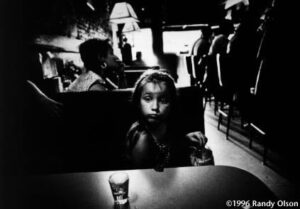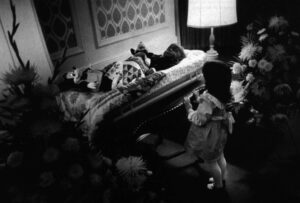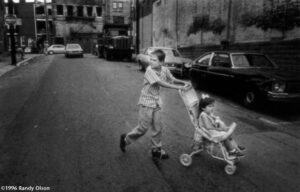Most Fridays, George Whitman doesn’t have the strength of will to take his four children to the community dinners for people affected by AIDS. There is the hour he spends in verbal combat with his two oldest boys – Corey, 15, and Ryan, 16, who want no part in the events. There is the hour’s bus ride each way from his family’s one-bedroom, run-down, rented home on the slopes of Pittsburgh’s South Side to the Episcopal church hall in the fashionable East End Shadyside district.
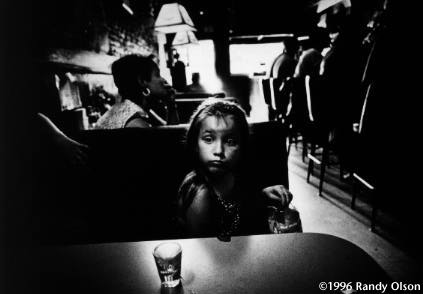
Often, he is just too tired to make the trek, a single parent with full-blown AIDS exhausted at the end of a long week working odd jobs at construction sites. He must work, he says, to pay the bills and keep food on the table; the family’s welfare and Social Security Disability income isn’t enough to make ends meet for a family of five.
Since January 1990 when he first learned he was infected with the AIDS virus, George has attended only three of the dinners painstakingly prepared by dozens of volunteers at the Shepherd Wellness Center, an interdenominational spiritual support network for people with AIDS and those connected to them.
At each of those, George went only as caretaker to his wife, Chris Skubis, as she struggled through the last six months of her illness. He went along to steady her as she shuffled over to her favorite table; to cut up the food she barely touched, to wait patiently in the background as she greeted old friends and survivors of old friends.
The Wellness Center was Chris’s place, not his, even though people tried to make him feel welcome. For years during the period when she and George were separated, the center and the Pittsburgh AIDS Task Force were her life lines and she guarded them fiercely. Often, at events like community dinners, Chris would point out George to her friends and tell them he was responsible for infecting her and two of their five children – the twins: Megan, who died in 1994, and Melody, 10. George would stand in the background looking off in the distance, pretending not to hear. After witnessing one of Chris’s unsparing put-downs, one physician wondered why George had bothered to return home to take charge of a family hurtling from crisis to crisis.
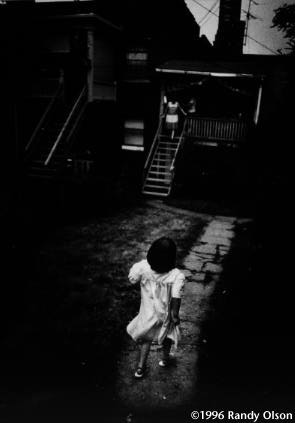
Many times, in the months since Chris died at his side in January of last year, George has wondered, too, about what brought him back home to face so much pain and responsibility. “The only thing I can figure is that the kids are better off with me than without,” he said recently during the car ride to pick up a bicycle he had put on layaway for one son’s birthday. “I don’t belong nowhere else and I’d be a real knucklehead of a Dad leaving them to get split up into foster homes.”
While Chris was able to find comfort and support by becoming something of an activist in Pittsburgh’s AIDS community, George has kept his distance – more uncomfortable about being so publicly connected to the disease.
Even without his wife’s bitterness, the Wellness dinners were an ordeal. He would often complain that the stress of coping on his own was often more manageable than the anxiety he had sharing a meal – good as it was – with several hundred strangers whose only bond is a disease that many would not dare mention at the other dinner tables in their lives.
Then comes the Wellness Center’s 1995 Christmas dinner and concert and everything is changed.
A manager at the Pittsburgh AIDS Task Force has convinced George to attend with daughter Melody and youngest son 11-year-old Matt, on the promise of a small surprise party for Melody’s birthday. Scores of volunteers have worked for weeks to turn a fellowship-worn church hall into a banquet room. There are plum-colored runners topped with lighted candles and centerpiece baskets of sugar-coated fruits and nuts. Each place-setting includes a favor bag of small gifts for each diner.
Before the buffet of citrus salad, stuffed Cornish game hens, potatoes with rosemary, mixed vegetables, home-baked breads and Christmas cookies, hundreds attend the Christmas service in the church. While the changing demographics of AIDS is evident in this group – many more emaciated young women, many more young children chasing each other through hallways than three years ago – most of the organizing, directing and volunteering comes from the gay community.
Indeed, the featured choir, Renaissance City, is made up of gay men, although George does not know that as he sits in the pew, one child on each side. He is a stand-out in the midst of all the holiday finery – men in bright, designer sweaters and jackets, women in rich wool skirts and crisp blouses.
George is a 47-year-old ex-con – tall and gaunt and bald except for a half-circle of curly gray hair running around the back of his head and to the bottom of his neck. He is dressed in jeans, a thread-bare dress shirt, a trucker’s cap and his trademark worn black leather jacket which he removes only when he sits down to eat. It is 10 minutes into the service when he elbows me in the side. “Why didn’t you tell me I had my cap on!” He whispers loudly as he whisks it off his head and crumples it in his large hands. “Feel like a real knucklehead!”
It is at this concert that all of George’s assumptions about being an outsider are upended in the time it takes 100 exquisite voices to sing ‘Happy Birthday’ in four-part harmony to a girl celebrating a milestone: Melody Whitman is one decade old, healthy and growing despite being HIV-positive since birth. It is impossible to gauge the emotional toll involved in her knowing she has the same virus that ended her mother’s life in January 1995 and her sister Meg’s several months before that.
“We would like to end our concert with a little acknowledgment for someone who has been part of our family for many years, someone we care about very much and someone we are so happy to see has reached her 10th birthday and is doing so well,” says the event’s director. The lights in the church are dimmed and all eyes turn to 10 candles on a huge sheet cake decorated with characters from Melody’s favorite movie “The Lion King.”
As Melody is called to the front of the church, George moves quietly to a side exit where he cries into his handkerchief as the choir sings. Melody, standing behind the cake and surrounded by the choir, is so overwhelmed that she begins to cry as well. It is an emotional opening for George to reflect on other milestones – good and bad. The past year has been filled with them – mental chalkmarks acknowledging inches gained and acres lost while trying to raise a family in the grip of AIDS.
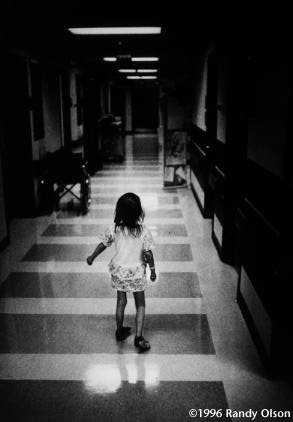
It is late in the evening of January 26, 1995, a cold night, but all the Whitman children are out of the house. They know that their mother, confined to a bed in the living room for several weeks, is dying. “She’s gonna die because she doesn’t even want a cigarette,” observes Ryan, the oldest, matter-of-factly as he heads out the door for a game of deck hockey. The children are tired of seeing their mother comatose, slowly slipping away, so they are staying with friends. On school days they have taken to leaving the house through the cellar door in order to avoid passing her by on the way out the front.
George is keeping vigil over his wife with the help of three of Chris’s friends, Evelyn Colledge, a home health aide, Beth Berger and Kim Dappen, Evelyn’s daughter. The air is thick with smoke as all three ease the waiting with cigarettes. Fast food hamburger wrappers and half-eaten bags of junk food are scattered throughout the living room.
At about 10 p.m., Evelyn moves over for her regular check of Chris’s pulse and respiration. She writes down the numbers in a small notebook.
“George, I’m sorry. Things don’t look good. Is there anyone you want to call?”
He is sitting on the hospital bed his wife rejected for the pink daybed used by their daughter, Meg, in her last months. He is rocking back and forth, staring out the window. “Well, she was raised Catholic and that’s what she wanted. She made me promise.”

George calls the rectory at the local parish and a priest answers. He is on the phone less than a minute and slams the receiver down. He is so angry his hands are shaking. “You know what he told me? He can’t make a visit to the house because we aren’t members of his parish. He said I should call the diocese on Monday and get the name of the person who has the AIDS ministry. What a God-damned jack ass!”
Beth is putting a cold washcloth on Chris’s forehead. “This is terrible. She’s just burning up here.” Kim snubs out a just-lit cigarette in the ashtray and tells her mother to call their parish priest on Pittsburgh’s North Side. Evelyn’s conversation also is brief. “He told me it was too late to come out here but he’s going to pray for her; he’ll do the prayers for the dying in bed. Can you believe this?”
Beth throws her arms up in the air. “Oh, well, why don’t we just put the phone up to her ear and he can do it before he goes to bed!”
We all sit in silence after that, listening to the rasping of Chris’s breathing. The women light up fresh cigarettes. George goes to the kitchen to make a pot of coffee. Mary Anne Fisher-Cerra, one of the case managers from the Pittsburgh AIDS Task Force, the one who later plans the 10th birthday surprise for Melody, calls in to check on Chris and is told about the uncooperative priests. She is unfazed about the callousness; she has seen and heard worse. “Call Father Lynn,” she says. “He’s an Episcopal priest but that’s close enough and he’s not going to let you down.”
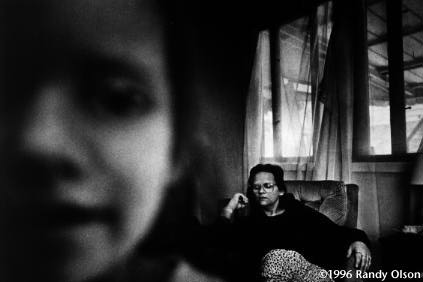
It is near midnight when Lynn Edwards, the director of Shepherd Wellness Center, pulls up in a tired old compact. The temperature is down in the teens and except for bus traffic, the streets are empty. He apologizes for being late and rushes inside. Calling everyone together around Chris, he apologizes for “my brothers in the clergy who seemed to have lost their way a bit tonight. You must understand that all of us are going to come up short at times, even those of us wearing collars.”
When Father Lynn has finished anointing Chris and leading the group in prayers, George is visibly relieved. He will have to keep vigil through the night and into early evening the next day before she dies. But at the moment of his final blessing, George has reached a milestone in accepting Chris’s impending death. “I promised I would get you a priest, baby, and I did,” he says whispering in the ear of his comatose wife.
It is five months later and George is on the phone with his sister in Eastern Pennsylvania. He has finally summoned the courage to tell his family he has AIDS. A group of social workers and health professionals who meet regularly to help manage his household have been pushing him toward this day for more than a year. His voice cracks only once on the phone when he tells his sister that Megan hadn’t died of leukemia as they said. “It’s been really hard keeping all these secrets,” he tells her. “But if you don’t, people will take it out on the kids.” His greatest fear is that his sister would be shocked and hang up on him.
She is shocked. She begins to cry but she tells him what he desperately needs to hear. She and his eight brothers will be there for him, she promises. They will find room to take in his children when he is no longer able. She invites George and the children to her home for a weekend and he goes out that same day to buy the bus tickets. Several months later there is a second trip to his sister’s home for a cousin’s wedding in which Melody is the flower girl. George has scrounged up more than $100 to buy her dress. “It may be the only time I see her walking down the aisle of a church,” he says. “I want it to be the best.” Days later, he talks about the wedding as another milestone. “When I saw my kids playing with their cousins it seemed like, ya, everything is going to be O.K. I may not be around but my kids will have a good life up there. It’s just a great feeling not to have to hide anything anymore.”
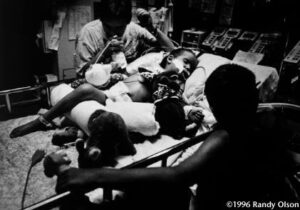 Another milestone memory revisits us in the buffet line at the Wellness Center Christmas dinner. George is loading up his plate with food and I recognize a young woman who has been staring at us from across the room. Her name is Bridget, a nurse who cared for Megan in several of her hospital stays but not her final one in the hospital’s intensive care unit, a situation that irritated Chris and George because Meg had responded so well to her.
Another milestone memory revisits us in the buffet line at the Wellness Center Christmas dinner. George is loading up his plate with food and I recognize a young woman who has been staring at us from across the room. Her name is Bridget, a nurse who cared for Megan in several of her hospital stays but not her final one in the hospital’s intensive care unit, a situation that irritated Chris and George because Meg had responded so well to her.
I re-introduce Bridget to George and invite her to sit with us for the meal. This Christmas is very difficult for him, the first after Chris’s death and a time when he becomes acutely aware of Megan’s absence. At home, an artificial Christmas tree is covered with mementos of Meg – small stuffed animals, a pair of her socks and pictures. He is reluctant to talk to Bridget at first; there is some awkwardness over the circumstances. But she is patient and pleasant and soon the two are reminiscing about Megan. It was George who put in an around-the-clock vigil in the ICU and was present with the nursing staff when Megan died. Soon the conversation shifts to the living. He chatters on about the other children – their improved report cards; outside activities; Melody’s health.

“I really thought that after going through Megan’s death, he would walk away and just keep walking,” I tell her out of George’s hearing. “He surprised a lot of us,” she says. Bridget has reached her own milestone this night: being able to explain to some former patients and their families why she was abruptly removed from patient care.
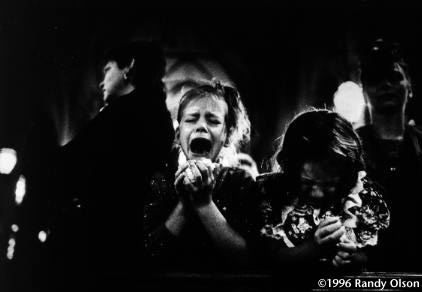

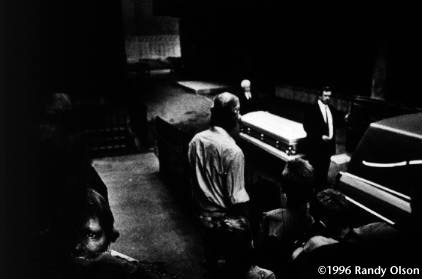

“Well, my crazy luck,” she says with a wan smile. “I’m here as a client, not a volunteer. One cracked vile of blood from a kid with end-stage AIDS, one really good gash on my hand and that’s all it took.” She shrugs her shoulders. “It’s funny. You talk to people who take such ridiculous chances over and over and they never get itand for me, one cut and boom.”
Bridget preferred to keep working but hospital officials insisted that if she did, she would have to keep her condition secret from patients – even other staff. “I couldn’t do that so I took myself out of patient care and some people didn’t understand.”
Now she is not working at all; looking back at her own milestones and trying to chart some others. “I always wanted to take a cruise to Alaska,” she says. “Maybe I will.”
@1996 Doug Root and Randy Olson
Doug Root is a freelance writer in Pittsburgh. Randy Olson is a freelance photographer in the same city. They have been illustrating the lives of one family grappling with AIDS for six years.

